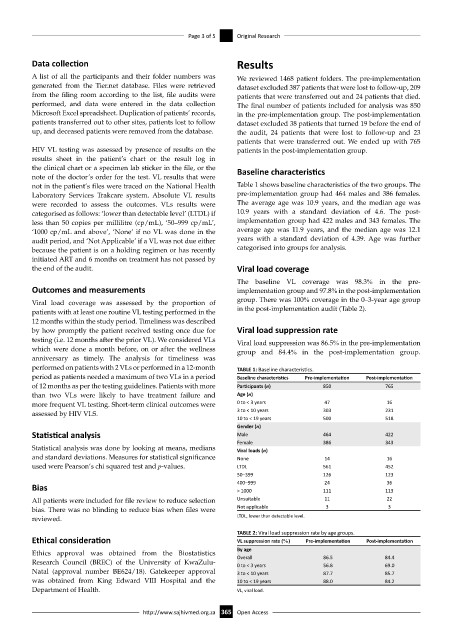Page 373 - HIVMED_v21_i1.indb
P. 373
Page 3 of 5 Original Research
Data collection Results
A list of all the participants and their folder numbers was We reviewed 1468 patient folders. The pre-implementation
generated from the Tier.net database. Files were retrieved dataset excluded 387 patients that were lost to follow-up, 209
from the filing room according to the list, file audits were patients that were transferred out and 24 patients that died.
performed, and data were entered in the data collection The final number of patients included for analysis was 850
Microsoft Excel spreadsheet. Duplication of patients’ records, in the pre-implementation group. The post-implementation
patients transferred out to other sites, patients lost to follow dataset excluded 38 patients that turned 19 before the end of
up, and deceased patients were removed from the database. the audit, 24 patients that were lost to follow-up and 23
patients that were transferred out. We ended up with 765
HIV VL testing was assessed by presence of results on the patients in the post-implementation group.
results sheet in the patient’s chart or the result log in
the clinical chart or a specimen lab sticker in the file, or the Baseline characteristics
note of the doctor’s order for the test. VL results that were
not in the patient’s files were traced on the National Health Table 1 shows baseline characteristics of the two groups. The
Laboratory Services Trakcare system. Absolute VL results pre-implementation group had 464 males and 386 females.
were recorded to assess the outcomes. VLs results were The average age was 10.9 years, and the median age was
categorised as follows: ‘lower than detectable level’ (LTDL) if 10.9 years with a standard deviation of 4.6. The post-
less than 50 copies per millilitre (cp/mL), ‘50–999 cp/mL’, implementation group had 422 males and 343 females. The
‘1000 cp/mL and above’, ‘None’ if no VL was done in the average age was 11.9 years, and the median age was 12.1
audit period, and ‘Not Applicable’ if a VL was not due either years with a standard deviation of 4.39. Age was further
because the patient is on a holding regimen or has recently categorised into groups for analysis.
initiated ART and 6 months on treatment has not passed by
the end of the audit. Viral load coverage
The baseline VL coverage was 98.3% in the pre-
Outcomes and measurements implementation group and 97.8% in the post-implementation
Viral load coverage was assessed by the proportion of group. There was 100% coverage in the 0–3-year age group
patients with at least one routine VL testing performed in the in the post-implementation audit (Table 2).
12 months within the study period. Timeliness was described
by how promptly the patient received testing once due for Viral load suppression rate
testing (i.e. 12 months after the prior VL). We considered VLs Viral load suppression was 86.5% in the pre-implementation
which were done a month before, on or after the wellness group and 84.4% in the post-implementation group.
anniversary as timely. The analysis for timeliness was
performed on patients with 2 VLs or performed in a 12-month TABLE 1: Baseline characteristics.
period as patients needed a maximum of two VLs in a period Baseline characteristics Pre-implementation Post-implementation
of 12 months as per the testing guidelines. Patients with more Participants (n) 850 765
than two VLs were likely to have treatment failure and Age (n)
more frequent VL testing. Short-term clinical outcomes were 0 to < 3 years 47 16
assessed by HIV VLS. 3 to < 10 years 303 231
10 to < 19 years 500 518
Gender (n)
Statistical analysis Male 464 422
Female 386 343
Statistical analysis was done by looking at means, medians Viral loads (n)
and standard deviations. Measures for statistical significance None 14 16
used were Pearson’s chi squared test and p-values. LTDL 561 452
50–399 126 123
24
36
Bias 400–999 111 113
> 1000
All patients were included for file review to reduce selection Unsuitable 11 22
bias. There was no blinding to reduce bias when files were Not applicable 3 3
reviewed. LTDL, lower than detectable level.
TABLE 2: Viral load suppression rate by age groups.
Ethical consideration VL suppression rate (%) Pre-implementation Post-implementation
By age
Ethics approval was obtained from the Biostatistics Overall 86.5 84.4
Research Council (BREC) of the University of KwaZulu- 0 to < 3 years 56.8 69.0
Natal (approval number BE624/18). Gatekeeper approval 3 to < 10 years 87.7 85.7
was obtained from King Edward VIII Hospital and the 10 to < 19 years 88.0 84.2
Department of Health. VL, viral load.
http://www.sajhivmed.org.za 365 Open Access

